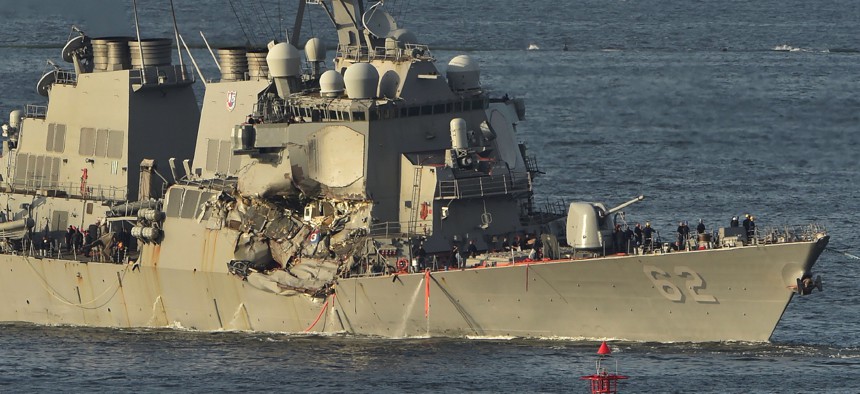
Could autonomous-navigation gear have prevented the 1997 collision of the guided missile destroyer USS Fitzgerald and a container ship? KAZUHIRO NOGI/AFP via Getty Images
US Navy May Put Autonomous Tech on Crewed Ships to Prevent Collisions
It’s the same technology already being used on uncrewed vessels.
The U.S. Navy is considering installing autonomous technology currently used on crewless ships on warships driven by sailors as a way to improve safety on the high seas.
The service has been testing uncrewed, autonomous ships and submarines, which officials consider a necessary piece of the future fleet. But the technology has largely been limited to exercises and sea trials, as policymakers grapple with how these vessels would be used in combat.
Installing autonomous and machine-learning technology on a crewed ship could be one way to prove the tech works, said Tom Reynolds, senior director of business development for Huntington Ingalls Industries’ Technical Solutions, a company that specializes in this type of technology.
“We don't have to jump to unmanned right away,” Reynolds said Tuesday at a Surface Warfare Association conference in Arlington, Virginia. “A bridge to getting the unmanned could be...the integration of autonomy onto manned platforms, and just have it run in the background.
The technology wouldn’t necessarily replace sailors, “but basically aid an overwhelmed bridge crew,” he said.
Last week, the Navy asked companies for ways these types of “bridge decision aid technologies” could “support safe navigation in Navy ships and submarines.” Installing this tech inside the bridge of crewed ships could “build user trust in the decision-aid solutions.”
This type of technology, Reynolds said, could possibly have aided the crews of the USS John S. McCain and the USS Fitzgerald, Arleigh Burke-class destroyers that collided with merchant ships in separate 2017 incidents. Lack of crew rest was cited as a contributing factor.
“Maybe had there been some kind of artificial intelligence aiding some decision-making, there could have been some help to a bridge crew that appeared to be overwhelmed or tired,” Reynolds said.




